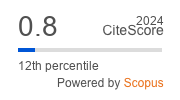Increasing the durability of electronic components in the inductive power supply system of implantable medical devices
https://doi.org/10.17073/1609-3577j.met202411.635
Abstract
The paper describes the problem of selecting electronic components in the inductive power supply system of implantable medical devices. It has been established that the use of components with low equivalent series resistance, as well as the use of capacitors with a temperature coefficient of capacitance of the NP0 type, allows reducing the heating of the inductive power transfer system with a class E power amplifier by more than 40%. A comparison of protective (conformal) coatings for reducing the heating of electronic components and increasing their resistance to the aggressive environment of the human body has been carried out. An experimental sample of the inductive power transfer system to implantable medical devices with a urethane conformal coating and a sealed polytetrafluoroethylene case has been developed and successfully tested on a laboratory animal.
Keywords
About the Author
K. O. GurovRussian Federation
1 Shokin Sq., Zelenograd, Moscow 124498
Konstantin O. Gurov — Junior Research
References
1. Gurov K.O., Mindubaev E.A. Designing a class E power amplifier for power electronics systems. Nanoindustry. 2020; 13(S5-1(102)): 190—196. (In Russ.). https://doi.org/10.22184/1993-8578.2020.13.5s.190.196
2. Mindubaev E.A., Gurov K.O. Elemental base for creating highly efficient systems of wireless power transmission. Nanoindustry. 2023; 16(S9-1(119)): 75—78. (In Russ.). https://doi.org/10.22184/1993-8578.2023.16.9s.75.78
3. Selyutina E.V., Gurov K.O., Mindubaev E.A., Danilov A.A. Parasitic components and heating of capacitors impact on power amplifier adaptive tuning in the inductive supply system for medical implants. Proceeding of University. Electronics. 2024; 29(1): 108—117. (In Russ.). https://doi.org/10.24151/1561-5405-2024-29-1-108-117
4. Phil K., Shikhov S. Conformal coatings for harsh operating conditions. Tekhnologii v elektronnoi promyshlennosti. 2020; (4(120)): 26—32. (In Russ.)
5. Seok S. Polymer-based biocompatible packaging for implantable devices: Packaging method, materials, and reliability simulation. Micromachines. 2021; 12(9): 1020. https://doi.org/1010.3390/mi12091020
6. Jeong J., Laiwalla F., Lee J., Ritasalo R., Pudas M.T., Larson L., Leung V., Nurmikko A. Conformal hermetic sealing of wireless microelectronic implantable chiplets by multilayered atomic layer deposition (ALD). Advanced Functional Materials. 2019; 29(5): 1806440. https://doi.org/10.1002/adfm.201806440
7. Baj-Rossi C., Kilinc E.G., Ghoreishizadeh S.S., Casarino D., Jost T.R., Dehollain C., Grassi F., Pastorino L., De Micheli G., Carrara S. Fabrication and packaging of a fully implantable biosensor array. In: 2013 IEEE Biomedical Circuits and Systems Conference (BioCAS), Rotterdam, Netherlands; 2013. P. 166—169. https://doi.org/10.1109/BioCAS.2013.6679665
8. Joung Y.-H. Development of implantable medical devices: from an engineering perspective. International Neurourology Journal. 2013; 17(3): 98—106. https://doi.org/10.5213/inj.2013.17.3.98
9. Hench L.L. Bioceramics. Journal of the American Ceramic Society. 1998; 81(7): 1705—1728. https://doi.org/10.1111/j.1151-2916.1998.tb02540.x
10. Suchanek W., Yashimura M. Processing and properties of hydroxyapatite-based biomaterials for use as hard tissue replacement implants. Journal of Materials Research. 1998; 13(01): 94—117. https://doi.org/10.1557/JMR.1998.0015
11. Mark J.E. (ed). Physical properties of polymers. NY: Springer; 2007. 1063 p.
12. Tikhonovsky M.A., Shepelev A.G., Kutny K.V., Nemashkalo O.V. Biomaterials: analysis of current trends of development on the basis of information flow data. Voprosy atomnoi nauki i tekhniki. Seriya: Vakuum, chistye materialy, sverkhprovodniki (17). 2008; (1): 166—172. (In Russ.)
13. Gurov K.O., Danilov A.A., Mindubaev E.A., Ryabchenko E.V., Surkov O.A. The assembly’s sheath for inductive powering of artificial organs. The International Journal of Artificial Organs. Abstracts from the 46th ESAO Congress 3–7 September 2019 Hannover, Germany. 2019; 42(8): 428.
14. Danilov A.A., Mindubaev E.A., Gurov K.O., Aubakirov R.R., Surkov O.A., Ryabchenko E.V., Selihchev S.V. Wireless powering of artificial organs: overcoming challenges. The International Journal of Artificial Organs. Abstracts from the 46th ESAO Congress 3–7 September 2019 Hannover, Germany. 2019; 42(8): 411.
Review
For citations:
Gurov K.O. Increasing the durability of electronic components in the inductive power supply system of implantable medical devices. Izvestiya Vysshikh Uchebnykh Zavedenii. Materialy Elektronnoi Tekhniki = Materials of Electronics Engineering. 2024;27(4):341-347. (In Russ.) https://doi.org/10.17073/1609-3577j.met202411.635






































